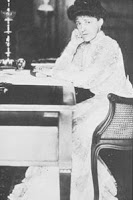 The New York City Landmarks Preservation Commission voted 6-3 on Tuesday to designate the B. F. Goodrich Company Building (1780 Broadway) as a landmark and at the same time reject the B. F. Goodrich Company Building at 225 West 57th Street. Although the buildings face adjacent streets, they are on the same lot and were both developed in 1909 by the same architect, Howard Van Doren Shaw, for the B. F. Goodrich Company. They are Shaw’s only extant buildings in New York.
The New York City Landmarks Preservation Commission voted 6-3 on Tuesday to designate the B. F. Goodrich Company Building (1780 Broadway) as a landmark and at the same time reject the B. F. Goodrich Company Building at 225 West 57th Street. Although the buildings face adjacent streets, they are on the same lot and were both developed in 1909 by the same architect, Howard Van Doren Shaw, for the B. F. Goodrich Company. They are Shaw’s only extant buildings in New York.
The Historic Districts Council issued the following Preservation Alert after the vote:
At today’s hearing, all nine commissioners present stated their support for the designation of 1780 Broadway, mentioning its architectural design but stressing its historic connection to Automobile Row. Six commissioners stated that 225 West 57th Street was of lesser significance because it did not have Broadway frontage and was “an accessory building” to the larger Goodrich headquarters. The other three commissioners defended the significance of the building and spoke highly of its architectural merit as well as its history of automobile-related uses.
225 West 57th Street, cureently under scaffolding and construction shroudOf particular interest was LPC Chair Robert Tierney’s statement referring to the City Council’s concerns about this designation. After the public hearing on August 11th, Council Members Daniel Garodnick, Melinda Katz, Jessica Lappin and Christine Quinn sent a joint letter to the Landmarks Preservation Commission opposing the designation of 225 West 57th Street based on “its drab appearance”, that “the company never occupied the building” and that “the designation of 225 West 57th Street could fatally compromise the footprint of the proposed development on this site”. This unprecedented message reframed deliberations about the significance-based worthiness of the buildings into “the argument for preservation against the economic development rationale… [of] allowing for new development on sites where buildings stand today”. Commissioner Tierney went on to state his belief that since there was a likelihood that the City Council would overturn the designation of 225 West 57th Street, the LPC should make a priority of designating 1780 Broadway which everyone agreed should be preserved.
The buildings’ preservation had been supported by HDC, other preservation groups and the local community boards on the basis of their significance to the development of New York City as the center for the nascent American automobile industry, as well as for the importance of the buildings’ architectural design. 225 West 57th Street specifically was a very early and unusual fusion of traditional and Modern design elements, using motifs and techniques from the Chicago and Viennese Secessionist Schools. These points were supported by research in the LPC’s files.
Representatives of the owner, Extell Development, as well as the American Institute of Architects/New York Chapter testified in favor of the designation of 1780 Broadway but opposed to 225 West 57th Street, stating that the buildings were only significant historically as they related to Automobile Row. Since West 57th Street was not on Automobile Row and the building was not occupied by the B. F. Goodrich Company, it was not worthy of being preserved. Additional owner’s representatives also stated that they might pursue a hardship application if 225 West 57th Street was designated (Extell is proposing to build a 60+-story building on the block including this site and has been assembling lots and air-rights to allow for this development for some time.)
In the end, it would appear that the developers won. Thanks to their lobbying efforts the City Council leadership was apparently convinced that this landmark designation was detrimental to the City. The Council’s opposition to the designation resulted in the Landmarks Preservation Commission’s rejection of the building. This is not how it should work.
HDC is exceptionally disappointed in the LPC’s yielding to political pressure. If the City Council was going to reject the designation of a worthy building, then the Council should have been put in a position of justifying that action. By ceding the designation of 225 West 25th Street, the LPC has set a terrible example for future designations.
HDC is also extraordinarily disturbed by the Council’s actions in this instance. While it is entirely appropriate for CM Daniel Garodnick to weigh in on a designation within his district, doing so before the community board has a chance to review the project is, at best, precipitous. The joint letter from the four council members, with its not-so-veiled threat, was a direct assault on the independence of the Landmarks Preservation Commission and the integrity of the Landmarks Law.
HDC has contacted these council members about our concerns over their involvement and we will be taking additional steps to make sure that the Landmarks Preservation Commission and their process remain transparent and independent. We look forward to updating you in the coming months.
Photo: 1780 Broadway, NYC




